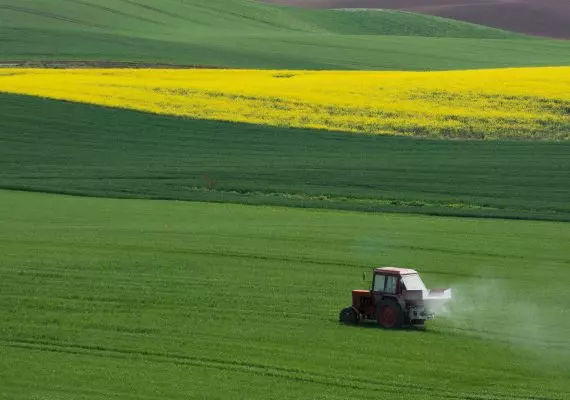
ACIDITY OF SOILS - WHAT IT DEPENDS ON
The soil acidity in Poland is not the same in all regions. This is due to the diversity of soil-forming and weather factors. We can also note that over several years, the soil acidity may change. This is caused by frequent rainfall and improper soil management by farmers. An unfavorable change in soil pH can also occur after industrial development begins in the vicinity of arable land.
We must remember that reducing the pH value of the soil leads to its degradation, significantly reducing yields. Regular treatments aimed at maintaining the pH at the proper level allow avoiding the need for reclamation of acidified soils. Regular pH adjustment protects against such a situation, but unfortunately, it increases the costs of agricultural production. Therefore, it is worth applying for subsidies for liming.
ENVIRONMENTAL SOIL REGENERATION PROGRAM - PURPOSE AND CONDITIONS FOR GRANTING SUBSIDIES FOR LIMING
The Management Board of the National Fund for Environmental Protection and Water Management has adopted a priority program entitled: "National Program for environmental soil regeneration through liming."
The program aims to support regenerative actions on acidified soils as a result of anthropogenic factors. Farmers can apply for support for regenerative liming of soils from 01.08.2019 at the appropriate District Chemical-Agricultural Stations, based on the results of chemical analysis of soil samples carried out by these stations.
Programem wsparcia są objęte użytki rolne, które na podstawie wyników analizy chemicznych próbek glebowych wykonanych przez OSChR mają odczyn kwaśny, tj. pH 5,5 i niższy. To szczególnie istotny program, gdyż ocenia się, że 72% użytków rolnych Polski jest w różnym stopniu zakwaszonych (b. kwaśne – 12%, kwaśne – 25%, lekko kwaśne – 35%). Przy czym gleby bardzo kwaśne i kwaśne stanowią 37% gleb użytkowanych rolniczo.
Dotacje do wapnowania gleb kwaśnych można uzyskać raz na cztery lata dla każdej działki rolnej spełniającej warunki przewidziane w programie. O tego typu dopłaty mogą się ubiegać rolnicy, którzy mają nie więcej niż 75 ha użytków rolnych. Jednak podstawowy warunek stanowi wykazanie, że pH gleb na działkach ewidencyjnych jest równe lub mniejsze 5,5.
The support program covers agricultural land which, according to the results of chemical analysis of soil samples conducted by the District Chemical-Agricultural Stations, has an acidic reaction, i.e., pH 5.5 and lower. This is a particularly important program, as it is estimated that 72% of Poland's agricultural land is to some extent acidified (very acidic - 12%, acidic - 25%, slightly acidic - 35%). Very acidic and acidic soils constitute 37% of agriculturally used soils. Subsidies for liming acidic soils can be obtained once every four years for each plot of agricultural land meeting the conditions specified in the program. Farmers with no more than 75 hectares of agricultural land can apply for such subsidies. However, the basic condition is to demonstrate that the pH of the soils on the registered plots is equal to or less than 5.5. The amount of the subsidy for liming depends on the size of the owned land. For farms up to 25 hectares of agricultural land, subsidies amount to PLN 300 per ton of lime, farmers with up to 50 hectares will receive PLN 200 subsidies for liming, and the largest farms, up to 75 hectares, can count on the financing of PLN 100 per ton of pure component. Subsidies are paid for the purchase of lime, not for its transportation and spreading in the field.
WHAT TO LIME ACIDIC SOIL WITH?
The decision on the choice of agricultural lime should be made based on current soil sample test results and fertilizer recommendations provided by the District Chemical-Agricultural Stations. It should be remembered that for acidic soils with low magnesium content, magnesium carbonate lime SuperMaghould always be used, which contains 40% CaO and 8% MgO. This fertilizer is produced from crushed magnesium meal, with 50% of the particles having a diameter smaller than 0.02 mm. The degree of comminution affects the chemical activity and the rate of dissolution in the soil environment. The more dusty fractions the lime-magnesium fertilizer contains, the larger the reaction surface with soil solutions becomes.
The magnesium-lime meal is then subjected to the granulation process, and the obtained fertilizer granules SuperMag SuperMag with a size of 2-8 mm allow for its uniform spreading. This fertilizer, applied at a rate of 500–1000 kg/ha raises the soil pH and increases the amount of absorbable magnesium, which performs several important physiological functions in the plant. This element regulates the intensity of photosynthesis because it determines the chlorophyll content in the leaves. Magnesium also affects energy processes in the plant, the synthesis of carbohydrates, fats, and proteins, as well as the transport of assimilates, and also limits the content of nitrates. It has been shown to stimulate the development of the root system and the processes of nutrient uptake by plants from the soil.
SuperMag SuperMag influences the rapid increase in soil pH and increases the absorbability of macronutrients, contributing to the improvement of the quality and yield of crops.
In the case of acidic soils with a high magnesium content, it is advisable to use granulated carbonate lime Polcalc III Generationwhich contains up to 52% CaO. This fertilizer is produced from very finely ground Jurassic limestone, with 50% of the meal particles having a diameter smaller than 0.02 mm. The lime meal is subjected to the granulation process. Therefore, the Polcalc III Generation has a beneficial effect on improving soil pH immediately after the dissolution of the fertilizer granules.
SuperMag and Polcalc III Generation are granulated fertilizers with very high reactivity (65-99%). These carbonate fertilizers are completely safe for plants and the soil environment. They can be used pre-sowing or top-dressing on growing plants, after emergence in the autumn and spring. The application of granulated fertilizers "before plowing" reduces the benefits of their use because the soil deacidification process becomes uneven, and the breakdown of granules is delayed. The fertilizer dose should be selected based on the results of soil sample tests and the fertilizer dosage tables in the SuperMag and Polcalc III Generation systems.
Application for liming subsidies.
Before applying for a liming subsidy, you must go to the District Chemical-Agricultural Station to test the soil reactions on plots that require liming, in your opinion. Based on the current OSChR test, an opinion on the recommended dose of the pure component will be issued. This document must be attached to the application. It should also contain information about the type of lime used. The subsidy is received after purchasing the product, so an invoice is also required for settlement. The application should include cadastral parcels of land and registration numbers of plots. In addition, it is important to declare the area of agricultural land because the amount of the liming subsidy depends on it.
The document is filled out electronically and then printed and signed. The application for liming subsidies should be submitted to the OSChR in this version.
For additional information about our products, please visit www.polcalc.pl and contact our distributors in Poland. www.polcalc.pl oraz do kontaktu z naszymi dystrybutorami na terenie Polski.






